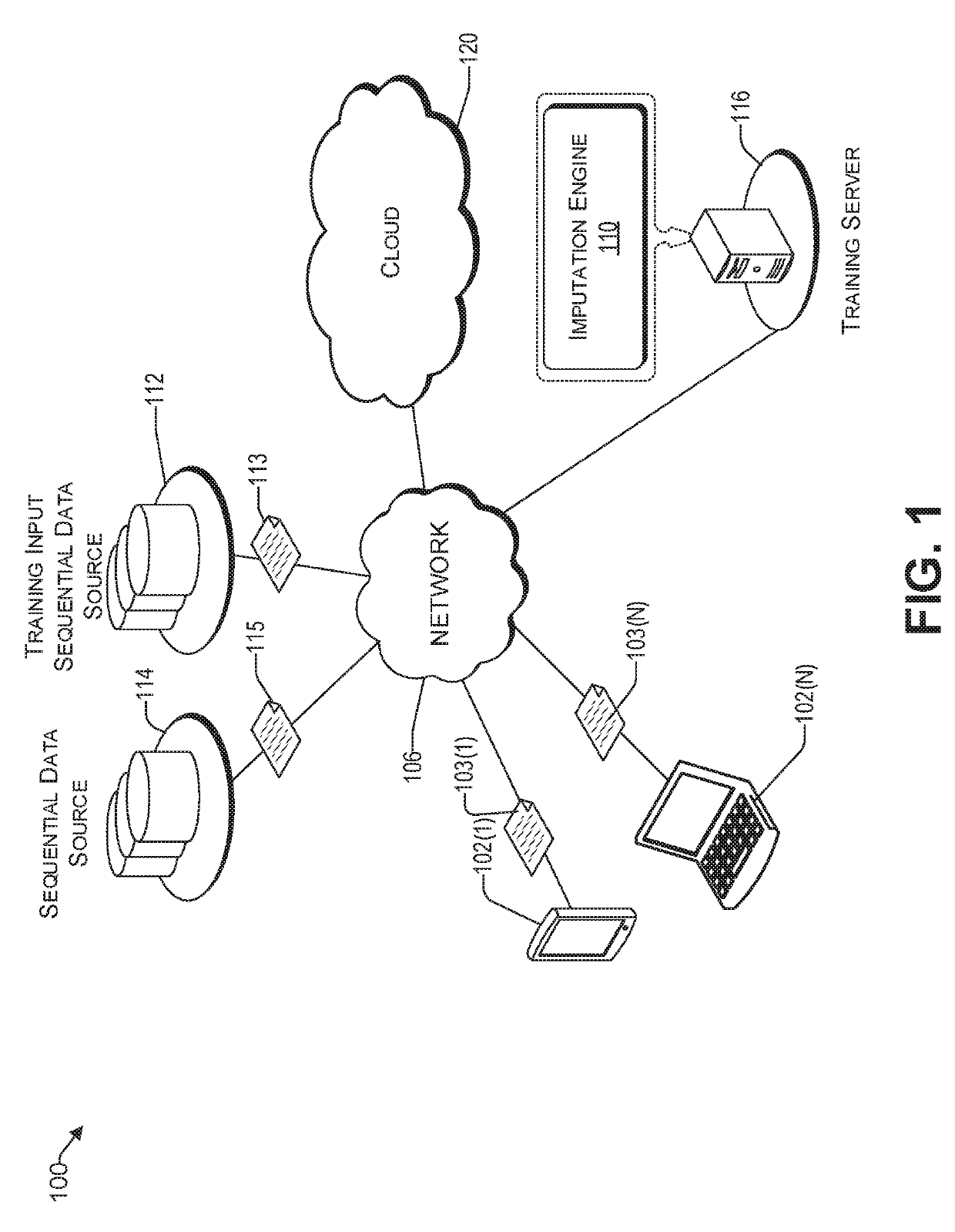Missing Values Imputation of Sequential Data
a technology of sequential data and missing values, applied in the field of data processing, can solve the problems of difficult sharing across different organizations, longitudinal ehr, and often incomplete results
- Summary
- Abstract
- Description
- Claims
- Application Information
AI Technical Summary
Benefits of technology
Problems solved by technology
Method used
Image
Examples
example architecture
[0019]FIG. 1 illustrates an example architecture 100 for implementing a system of imputing missing values of sequential data. Architecture 100 includes a network 106 that allows various computing devices 102(1) to 102(N) to communicate with each other, as well as other elements that are connected to the network 106, such as a sequential data source 112 that is configured to provide sequential training data 113, a sequential data source 114, that may provide corrupted sequential data 115 that is to be processed by the imputation engine 110. In various embodiments, the sequential data 115 may be received and processed at predetermined intervals (e.g., as the data becomes available) or in batch.
[0020]The network 106 may be, without limitation, a local area network (“LAN”), a virtual private network (“VPN”), a cellular network, the Internet, or a combination thereof. For example, the network 106 may include a mobile network that is communicatively coupled to a private network, sometimes...
example recurrent
Neural Network
[0030]A recurrent neural network (RNN) is a type of neural network where connections between units form a predetermined orderly cycle. An RNN is able to analyze data to identify a dynamic temporal behavior. Unlike feedforward neural networks, where connections between the units do not form a cycle, RNNs can use their memory to process arbitrary sequences of inputs. Accordingly, RNN's are particularly useful in determining patterns in data that change over time. For example, in predicting a missing word in a sentence, it is helpful to know the preceding word(s). Thus, RNN' s leverage the dependence of a previous state of an input to determine its next state. In this way, an RNN can learn a probability distribution over a sequence by being trained to predict the next symbol in a sequence.
[0031]FIG. 3 illustrates an example RNN block diagram. The input x (302, 322, 342, etc.,) may vary overtime (i.e., the input x has a temporal relationship). For example, xt is the input ...
example process
[0045]With the foregoing overview of the architecture 100 and the conceptual diagram of an RNN autoencoder systems 400A that can be trained to accommodate corrupted input data and its trained variant 400B, it may be helpful now to consider a high-level discussion of an example process. To that end, FIG. 5 presents an illustrative process 500 of imputing missing values of sequential data by an imputation engine. Process 500 is illustrated as a collection of blocks in a logical flowchart, which represents a sequence of operations that can be implemented in hardware, software, or a combination thereof. In the context of software, the blocks represent computer-executable instructions that, when executed by one or more processors, perform the recited operations. Generally, computer-executable instructions may include routines, programs, objects, components, data structures, and the like that perform functions or implement abstract data types. The order in which the operations are describ...
PUM
 Login to View More
Login to View More Abstract
Description
Claims
Application Information
 Login to View More
Login to View More - R&D
- Intellectual Property
- Life Sciences
- Materials
- Tech Scout
- Unparalleled Data Quality
- Higher Quality Content
- 60% Fewer Hallucinations
Browse by: Latest US Patents, China's latest patents, Technical Efficacy Thesaurus, Application Domain, Technology Topic, Popular Technical Reports.
© 2025 PatSnap. All rights reserved.Legal|Privacy policy|Modern Slavery Act Transparency Statement|Sitemap|About US| Contact US: help@patsnap.com



